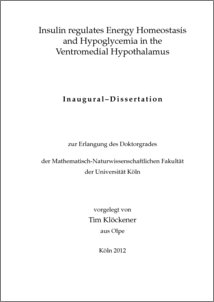Tim, Klöckener
(2011).
Insulin regulates Energy Homeostasis and Hypoglycemia in the Ventromedial Hypothalamus.
PhD thesis, Universität zu Köln.

![[img]](https://kups.ub.uni-koeln.de/style/images/fileicons/application_pdf.png)  Preview |
|
PDF (Dissertation)
Promotion-final-TimKloeckener.pdf
- Accepted Version
Download (11MB)
|
Abstract
Growing evidence from the last decades intimately links obesity with insulin resistance and type 2 diabetes mellitus as a consequence. Thus, the role of the central nervous system and especially the hypothalamus in the control of energy homeostasis are intensively investigated. The melanocortin system has been identified as a pivotal neurocircuit in this homeostatic process, but many other neuronal populations are similarly involved. Furthermore, the role of insulin as adiposity signal in the control of energy homeostasis has to be further clarified. In particular, steroidogenic factor 1 (SF-1)-expressing neurons of the ventromedial hypothalamus (VMH) control energy homeostasis, but the role of insulin action in these cells remains undefined. This study shows that insulin activates phosphatidylinositol-3-kinase (PI3K) signaling in SF-1 neurons and reduces firing frequency in these cells by the activation of ATP-dependent potassium (KATP) channels. These effects were abrogated in mice with Cre-mediated insulin receptor deficiency restricted to SF-1 neurons (SF-1∆IR mice). Whereas body weight and glucose homeosta- sis remained the same in SF-1∆IR mice as in controls on a normal chow diet, they were protected from diet-induced leptin resistance, weight gain, adiposity and impaired glucose tolerance. High-fat feeding activated PI3K signaling in SF-1 neurons of control mice, and this response was attenuated in the VMH of SF-1∆IR mice. Mimicking diet- induced overactivation of PI3K signaling by disruption of the phosphatidylinositol-3,4,5- trisphosphate phosphatase PTEN led to increased body weight and hyperphagia under normal chow diet conditions. Collectively, this study reveals that high-fat diet–induced, insulin-dependent PI3K activation in VMH neurons contributes to obesity development.
Additionally, insulin was identified as a necessary signal in SF-1 VMH neurons involved in the induction of the counter-regulatory response to hypoglycemia, one of the major limitations for insulin treatment in diabetic patients.
| Item Type: |
Thesis
(PhD thesis)
|
| Translated abstract: |
| Abstract | Language |
|---|
| Zunehmende Erkenntnisse der letzten Jahrzehnte konnten zeigen, dass Übergewicht und Insulin Resistenz, mit Typ 2 Diabetes Mellitus als Folge, stark assoziierte Zustände sind. Deshalb werden die Rolle des zentralen Nervensystems und speziell des Hypothalamus in der Kontrolle der Energie Homöostase intensiv erforscht. Das Melanokortin System innerhalb des Hypothalamus wurde als zentrales neuronales Netzwerk für diesen homöostatischen Prozess identifiziert. Die Effekte von Insulin als Sättigungssignal innerhalb des Gehirns waren ebenfalls Gegenstand der Forschung der letzten Jahre. Des weiteren wurden Steroidogenic Factor 1 (SF-1) exprimierende Neuronen innerhalb des ventromedialen Hypothalamus (VMH) als beteiligte Neuronenpopulation in der Kontrolle der Energie Homöostase identifiziert, jedoch wurde die Rolle des Insulinsignalwegs in diesen Zellen bisher noch nicht erforscht. Die vorliegende Arbeit konnte zeigen, dass Insulin in SF-1 Neuronen den Phosphatidylinositol-3-kinase (PI3K) Signalweg stimuliert und damit die Aktivität dieser Neurone durch das Steuern von ATP-abhängigen Kalium (KATP) Kanälen herabsetzt. Dieser Effekt war in Mäusen denen der Insulinzezeptor in SF-1 exprimierenden Neuronen fehlt (SF-1∆IR) nicht mehr vorhanden. Diese Defizienz hatte unter normalen Fütterungsbedingungen keine Auswirkungen, wurden die Mäuse jedoch mit einer fettreichen Diät gefüttert, waren SF-1∆IR Tiere zum Teil vor ernährungsbedingter Gewichtszunahme, Leptinresistenz, Fettleibigkeit und Glukoseintoleranz geschützt. Die Deletion der PI3K-spezifischen Phosphatidylinositol-3,4,5-trisphosphate Phosphatase PTEN dagegen führte zu Übergewicht und Hyperphagie unter Normal-Futter Bedingungen, da die durch fettreiche Ernährung bedingte Überaktivierung der PI3K imitiert wird. Zusammenfassend konnte wurde gezeigt, dass die ernährungs-bedingte Überaktivierung der PI3K in VMH SF-1 Neuronen zur Entwicklung von Übergewicht beiträgt.
Des Weiteren konnte gezeigt werden, dass der Insulinsignalweg in SF-1 Neuronen für die Aktivierung der Leber-spezifischen Glukoneogenese zur Verhinderung von Hypo- glykämie, welches eine der Hauptkomplikationen der Insulintherapie darstellt, notwendig ist. | German |
|
| Creators: |
| Creators | Email | ORCID | ORCID Put Code |
|---|
| Tim, Klöckener | Tim.Kloeckener@uni-koeln.de | UNSPECIFIED | UNSPECIFIED |
|
| URN: |
urn:nbn:de:hbz:38-50713 |
| Date: |
19 September 2011 |
| Language: |
English |
| Faculty: |
Faculty of Mathematics and Natural Sciences |
| Divisions: |
Faculty of Mathematics and Natural Sciences > Department of Biology > Institute for Genetics |
| Subjects: |
Life sciences |
| Uncontrolled Keywords: |
| Keywords | Language |
|---|
| Insulin | English | | Ventromedial Hypothalamus | English | | Energy Homeostasis | English |
|
| Date of oral exam: |
4 December 2012 |
| Referee: |
| Name | Academic Title |
|---|
| Brüning, Jens | Prof. Dr. |
|
| Refereed: |
Yes |
| URI: |
http://kups.ub.uni-koeln.de/id/eprint/5071 |
Downloads per month over past year
Export
Actions (login required)
 |
View Item |


